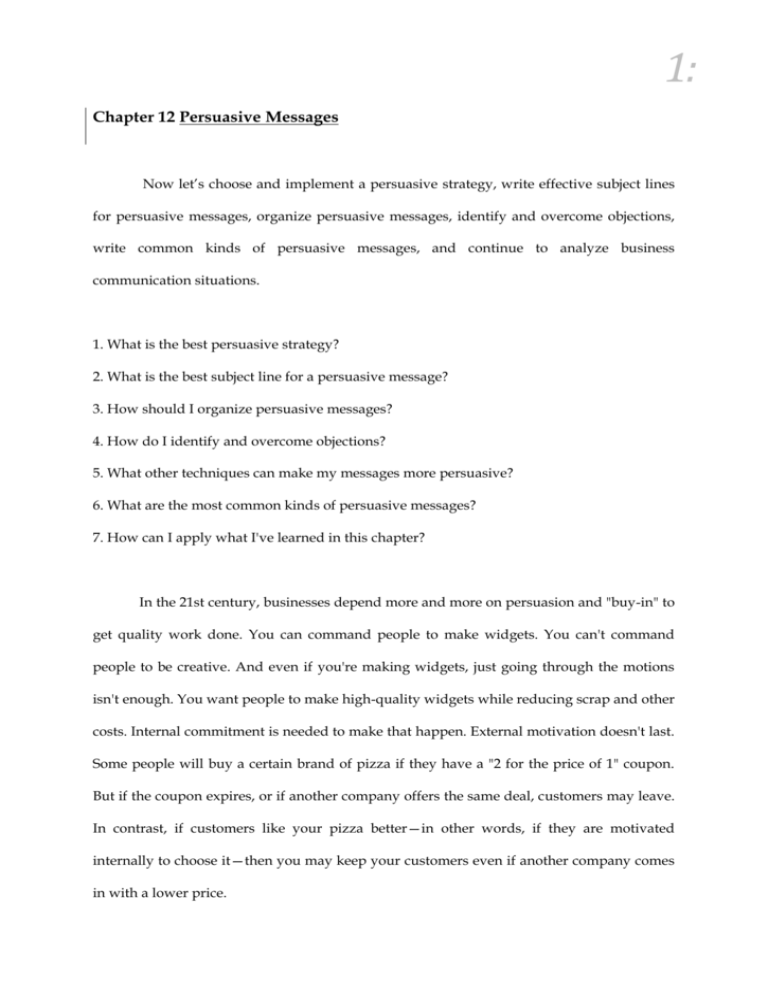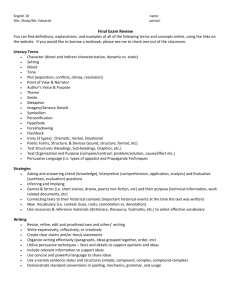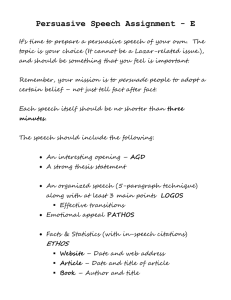Chapter 12 Persuasive Messages
advertisement

1: Chapter 12 Persuasive Messages Now let’s choose and implement a persuasive strategy, write effective subject lines for persuasive messages, organize persuasive messages, identify and overcome objections, write common kinds of persuasive messages, and continue to analyze business communication situations. 1. What is the best persuasive strategy? 2. What is the best subject line for a persuasive message? 3. How should I organize persuasive messages? 4. How do I identify and overcome objections? 5. What other techniques can make my messages more persuasive? 6. What are the most common kinds of persuasive messages? 7. How can I apply what I've learned in this chapter? In the 21st century, businesses depend more and more on persuasion and "buy-in" to get quality work done. You can command people to make widgets. You can't command people to be creative. And even if you're making widgets, just going through the motions isn't enough. You want people to make high-quality widgets while reducing scrap and other costs. Internal commitment is needed to make that happen. External motivation doesn't last. Some people will buy a certain brand of pizza if they have a "2 for the price of 1" coupon. But if the coupon expires, or if another company offers the same deal, customers may leave. In contrast, if customers like your pizza better—in other words, if they are motivated internally to choose it—then you may keep your customers even if another company comes in with a lower price. 2: Use the direct request pattern when The audience will do as you ask without any resistance. You need a response only from the people who are willing to act. The audience is busy and may not read all the messages received. Your organization's culture prefers direct requests. Use the problem-solving pattern when The audience is likely to object to doing as you ask. You need action from everyone. You trust the audience to read the entire message. You expect logic to be more important than emotion in the decision. In a direct request, put the request, the topic of the request, or a question in the subject line. Do not put the request in the subject line of a problem-solving persuasive message. Instead, use a directed subject line that reveals your position on the issue or a reader benefit. Use a positive or neutral subject line even when the first paragraph will be negative. In a direct request, consider asking in the first paragraph for the information or service you want. Give readers all the information or details they will need to act on your request. In the last paragraph, ask for the action you want. Organize a problem-solving persuasive message in this way: 1. Describe a problem you both share (which your request will solve). 2. Give the details of the problem. 3. Explain the solution to the problem. 4. Show that any negative elements (cost, time, etc.) are outweighed by the advantages. 3: 5. Summarize any additional benefits of the solution. 6. Ask for the action you want. Readers have a vested interest in something if they benefit directly from keeping things as they are. Use one or more of the following strategies to counter objections: Specify how much time and/or money is required. Put the time and/or money in the context of the benefits they bring. Show that money spent now will save money in the long run. Show that doing as you ask will benefit some group the reader identifies with or some cause the reader supports. Show the reader that the sacrifice is necessary to achieve a larger, more important goal to which he or she is committed. Show that the advantages as a group outnumber or outweigh the disadvantages as a group. Turn the disadvantage into an opportunity. To encourage readers to act promptly, set a deadline. Show that the time limit is real, that acting now will save time or money, or that delaying action will cost more. Use the PAIBOC questions to analyze persuasive situations.






